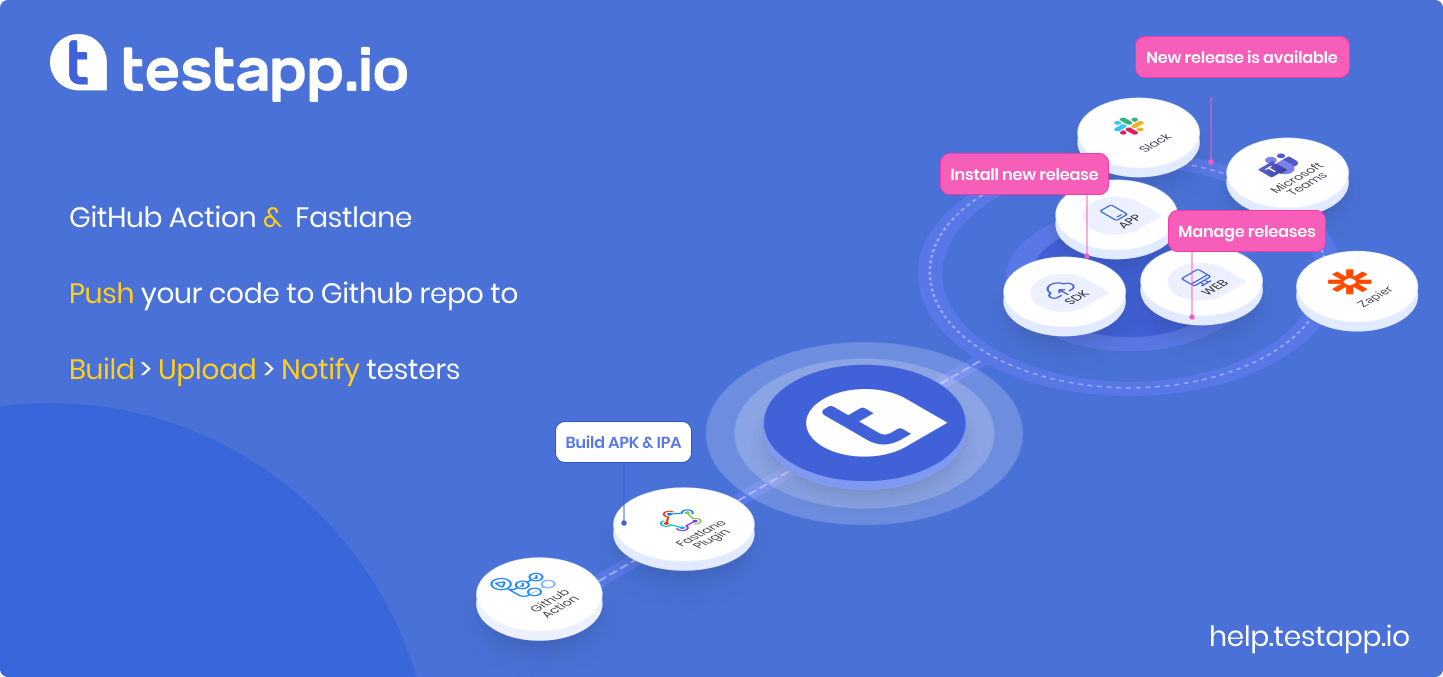GitHub Action with TestApp.io Fastlane Plugin allows you to build and upload both Android & iOS apps to TestApp.io to notify your testers for testing and feedback.
Configuration
| Key | Description | Env Var(s) | Default |
|---|---|---|---|
| api_token | You can get it from https://portal.testapp.io/settings/api-credentials | TESTAPPIO_API_TOKEN | |
| app_id | You can get it from your app page at https://portal.testapp.io/apps | TESTAPPIO_APP_ID | |
| release | It can be either both or Android or iOS | TESTAPPIO_RELEASE | |
| apk | Path to the Android APK file | TESTAPPIO_ANDROID_PATH | |
| ipa | Path to the iOS IPA file | TESTAPPIO_IOS_PATH | |
| release_notes | Manually add the release notes to be displayed for the testers | TESTAPPIO_RELEASE_NOTES | |
| git_release_notes | Collect release notes from the latest git commit message to be displayed for the testers: true or false | TESTAPPIO_GIT_RELEASE_NOTES | true |
| git_commit_id | Include the last commit ID in the release notes (works with both release notes options): true or false | TESTAPPIO_GIT_COMMIT_ID | false |
| notify | Send notifications to your team members about this release: true or false | TESTAPPIO_NOTIFY | false |
Check TA-CLI for more info
iOS
We will demonstrate with our sample iOS project, testappio-ios-sample-app to show how Github Action + Fastlane + TestApp plugin works.
Configure iOS project for Fastlane
- Install Fastlane
The below command works for most cases. If not, please read this - Setup Fastlane
bundle install fastlane
- Init Fastlane
In the iOS project folder
bundle exec fastlane init
And follow the wizard; it will create ./fastlane/Appfile with your Apple ID and team.
- Init
Match
Fastlane match is a tool for generating all necessary certificates, provisioning profiles and storing them in a Git repository encrypted.
Create a private empty GitHub repository for storing certificates and provisioning profiles.
bundle exec fastlane match init
Follow the instruction, give the new empty git repository when asked, and it will create the Matchfile.
- Generate the certificate and provision profile
bundle exec fastlane match adhoc
Following the instruction, it will generate certificates/profiles and store them in the Git repository specified in the previous step.
- Select provisioning profiles in Xcode
The newly created certificates and profiles should now be possible to select inside our project. Open up Xcode and go to Signing & Capabilities.
- Using
testappioplugin for Fastlane
bundle exec fastlane add_plugin testappio
- Create a Repository level Secret
MATCH_PASSWORDthis is the one you specified while generating the Certificates and Profiles.
How to configure **secret** for GitHub actions
Go to GitHub repository Settings Page, to Secrets, and then Actions; click on New repository secret to configure a new secret.
Then, you can refer to it in your GitHub workflow as ${{ secret.app_id }}
-
Create a Repository level Secret
FASTLANE_PASSWORDthis is the password of your Apple ID. -
Create a Repository level Secret
MATCH_GIT_BASIC_AUTHORIZATIONfor accessing the Certification/Profile repository.
Navigate to Tokens to generate a Personal Access Token, MATCH_GIT_BASIC_AUTHORIZATION can be generated below
echo -n your_github_username:your_personal_access_token | base64
- Create Repository level Secrets
TESTAPPIO_API_TOKENandTESTAPPIO_APP_ID
Run the pipeline
- Finally, create the
lane
Create: ./fastlane/Fastfile and copy the below content:
default_platform(:ios)
platform :ios do
desc "Build the adhoc and upload to TestApp.io"
lane :development do
match(type: "adhoc")
gym(export_method: "ad-hoc")
upload_to_testappio(
release_notes: "My release notes here..."
)
end
end
More info on the Fastlane plugin: https://help.testapp.io/fastlane-plugin/#testappio-actions
You may already have your lane in place; copy the upload_to_testappio action and put it into your pipeline after the IPA export.
- The GitHub Workflow:
Create: .github/workflows/ios.yml file under your project root folder. E.g.
name: Build & upload IPA to TestApp.io
on:
workflow_dispatch:
push:
branches: [ main ]
pull_request:
branches: [ main ]
jobs:
ios:
name: Build and upload to TestApp.io
runs-on: macos-latest
steps:
- name: Checkout
uses: actions/checkout@v3
- name: Setup Ruby
uses: ruby/setup-ruby@v1
with:
ruby-version: '2.7.2'
- uses: maierj/[email protected]
env:
MATCH_PASSWORD: ${{ secrets.MATCH_PASSWORD }}
FASTLANE_PASSWORD: ${{ secrets.FASTLANE_PASSWORD }}
TESTAPPIO_API_TOKEN: ${{ secrets.TESTAPPIO_API_TOKEN }}
TESTAPPIO_APP_ID: ${{ secrets.TESTAPPIO_APP_ID }}
MATCH_GIT_BASIC_AUTHORIZATION: ${{ secrets.MATCH_GIT_BASIC_AUTHORIZATION }}
with:
lane: 'ios development'
verbose: true
- Commit and push the change to trigger the GitHub Action.
Android
We will demonstrate with our sample Android project testappio-android-sample, how GitHub Action + Fastlane + TestApp plugin works.
- Create Repository level Secrets
TESTAPPIO_API_TOKENandTESTAPPIO_APP_ID
2. Create .github/workflows/main.yml file
name: Build & upload APK to TestApp.io
on:
workflow_dispatch:
push:
branches: [ main ]
pull_request:
branches: [ main ]
jobs:
ios:
name: Build and upload to TestApp.io
runs-on: ubuntu-latest
steps:
- name: Checkout
uses: actions/checkout@v3
- name: Setup Ruby
uses: ruby/setup-ruby@v1
with:
ruby-version: '2.7.2'
- uses: maierj/[email protected]
env:
TESTAPPIO_API_TOKEN: ${{ secrets.TESTAPPIO_API_TOKEN }}
TESTAPPIO_APP_ID: ${{ secrets.TESTAPPIO_APP_ID }}
with:
lane: 'android development'
verbose: true
3. Create fastlane/Fastfile file
default_platform(:android)
platform :android do
desc "Submit a new Build to TestApp.io"
lane :development do
increment_version_code
gradle(task: "clean assembleDebug")
upload_to_testappio(
release_notes: "My release notes here..."
)
end
end4. Commit and push the change to trigger the GitHub Action.
Feedback & Support
Developers built TestApp.io to solve the pain of app distribution for mobile app development teams.
Join our community for feedback and support.
Happy releasing 🎉
